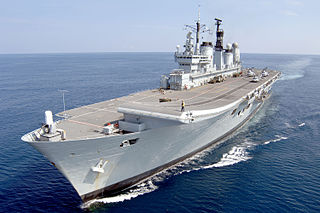
The Invincible class was a class of light aircraft carrier operated by the Royal Navy. Three ships were constructed: HMS Invincible, HMS Illustrious and HMS Ark Royal. The vessels were built as aviation-capable anti-submarine warfare (ASW) platforms to counter the Cold War North Atlantic Soviet submarine threat, and initially embarked Sea Harrier aircraft and Sea King HAS.1 anti-submarine helicopters. With cancellation of the aircraft carriers renewal programme in the 1960s, the three ships became the replacements for Ark Royal and Eagle fleet carriers and the Centaur-class light fleet carriers, and the Royal Navy's sole class of aircraft carrier.
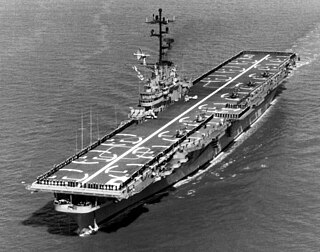
USS Princeton was one of 24 Essex-class aircraft carriers built during and shortly after World War II for the United States Navy. The ship was the fifth US Navy ship to bear the name, and was named for the Revolutionary War Battle of Princeton. Princeton was commissioned in November 1945, too late to serve in World War II, but saw extensive service in the Korean War, in which she earned eight battle stars, and the Vietnam War. She was reclassified in the early 1950s as an attack carrier (CVA), then as an Antisubmarine Aircraft Carrier (CVS), and finally as an amphibious assault ship (LPH), carrying helicopters and marines. One of her last missions was to serve as the prime recovery ship for the Apollo 10 space mission.

USS Thetis Bay (CVE-90) was the thirty-sixth of fifty Casablanca-class escort carriers built for the United States Navy during World War II. She was launched in March 1944, commissioned in April, and served as a transport carrier in the Pacific, as well as a replenishment carrier supporting the Allied bombardment of Tokyo and the Main Islands. Postwar, she participated in Operation Magic Carpet, before being decommissioned in August 1946, being mothballed in the Pacific Reserve Fleet. She was reactivated in July 1956, and converted to a helicopter transport carrier, serving in relief operations in Taiwan and Haiti. Ultimately, she was broken up in 1966, the last Casablanca-class hull to be scrapped.
USS Tripoli may refer to:

USS Guam (LPH-9), was an Iwo Jima-class amphibious assault ship, and was laid down by the Philadelphia Naval Shipyard on 15 November 1962; launched on 22 August 1964, sponsored by Mrs. Vaughn H. Emory Green, and commissioned on 16 January 1965. She was the third US Navy ship to carry the name, after the US Territory of Guam.
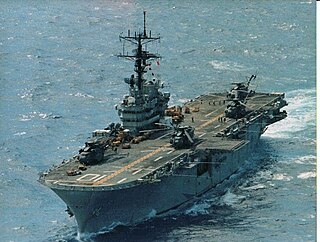
USS Tripoli (LPH-10), an Iwo Jima-class amphibious assault ship, was laid down on 15 June 1964 at Pascagoula, Mississippi, by the Ingalls Shipbuilding Corporation; launched on 31 July 1965; sponsored by Jane Cates, the wife of General Clifton B. Cates, former Commandant of the Marine Corps; and commissioned on 6 August 1966 at the Philadelphia Naval Shipyard. Tripoli was the second US Navy ship named for the Battle of Derna in 1805. It was the decisive victory of a mercenary army led by a detachment of US Marines and US Army soldiers against the forces of Tripoli during the First Barbary War. It was the first recorded land battle of the United States fought overseas.

USS New Orleans (LPH-11) was an Iwo Jima-class amphibious assault ship in the United States Navy. She was the third Navy ship to be so named, and is the first named for the Battle of New Orleans, which was the last major battle of the War of 1812.
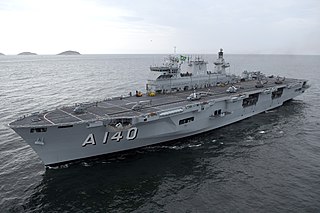
Landing platform helicopter (LPH) is a term used by some navies to denote a type of amphibious warfare ship designed primarily to operate as a launch and recovery platform for helicopters and other VTOL aircraft. As such, they are considered a type of helicopter carrier.

The Iwo Jima-class amphibious assault ships of the United States Navy were the first amphibious assault ships designed and built as dedicated helicopter carriers, capable of operating up to 20 helicopters to carry up to 1,800 marines ashore. They were named for battles featuring the United States Marine Corps, starting with the Battle of Iwo Jima. The first ship of the class was commissioned in 1961, and the last was decommissioned in 2002. The hull classification of "LPH" stands for "Landing Platform Helicopter".
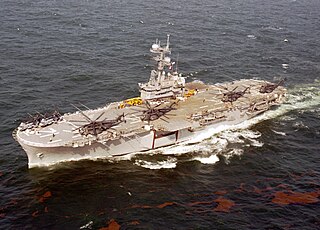
USS Inchon (LPH/MCS-12) was an Iwo Jima-class amphibious assault ship of the United States Navy in service from 1970 to 2002. Following a major fire, she was laid up and sunk as a target in 2004.

USS Noxubee (AOG-56) was a Patapsco-class gasoline tanker acquired by the U.S. Navy for the task of transporting gasoline to warships in the fleet, and to remote Navy stations. She served in a commissioned status from 1945 to 1959, and 1965–1975. She was named for a river in Mississippi.
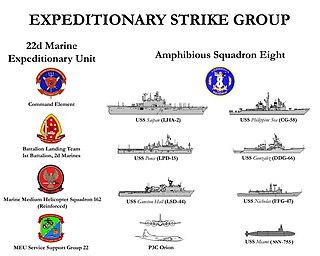
In the United States Navy, the expeditionary strike group (ESG) is a coordinated group of surface ships, aircraft, submarines, and other naval assets. In contrast to carrier strike groups (CSGs), which emphasize air power and are led by a supercarrier, ESGs are strongly suited for amphibious warfare and are led by an amphibious assault ship. The ESG concept was introduced in the early 1990s, based on the Naval Expeditionary Task Force. The U.S. Navy fields nine expeditionary strike groups.
Operation Golden Dragon was a combined United States-South Korea military naval training exercise in February 1973. The operation was held outside of Yang Po Ri island, South Korea. The exercise was designed to train the South Korea's naval troops and prepare South Korea for any attack from North Korea or Japan.

USS Impervious (AM-449/MSO-449) was an Agile-class minesweeper acquired by the U.S. Navy for the task of removing mines that had been placed in the water to prevent the safe passage of ships.

USS Leader (AM-490/MSO-490) was an Agile-class minesweeper acquired by the U.S. Navy for the task of removing mines that had been placed in the water to prevent the safe passage of ships.

USS Adroit (AM-509/MSO-509) was an Acme-class minesweeper acquired by the U.S. Navy for the task of removing mines that had been placed in the water to prevent the safe passage of ships.

An amphibious assault ship is a type of amphibious warfare ship employed to land and support ground forces on enemy territory during an amphibious assault. The design evolved from aircraft carriers converted for use as helicopter carriers. Modern designs support amphibious landing craft, with most designs including a well deck. Like the aircraft carriers they were developed from, some amphibious assault ships also support V/STOL fixed-wing aircraft and have a secondary role as aircraft carriers.

USS Mount Vernon (LSD-39) was an Anchorage-class dock landing ship of the United States Navy. She was the fifth ship of the U.S. Navy to bear the name. She was built in Massachusetts in 1972 and homeported in Southern California for 31 years until being decommissioned on 25 July 2003. Mount Vernon acted as the control ship for the cleanup of the Exxon Valdez oil spill. In 2005, she was intentionally destroyed off the coast of Hawaii as part of a training exercise. USS Mount Vernon also appeared in the Season 7 episode 19 of The Love Boat when they visited Hong Kong.

USS Tripoli (LHA-7) is the second America-class amphibious assault ship built for the United States Navy. On 7 May 2012, United States Secretary of the Navy Ray Mabus announced the ship's name as Tripoli, in honor of the US Marine Corps victory against Tripoli at the Battle of Derna during the First Barbary War. This is the third US Naval ship to carry the name, the first being USS Tripoli (CVE-64), an escort carrier from World War II and the second being USS Tripoli (LPH-10), an amphibious assault ship that served during the Cold War.
















